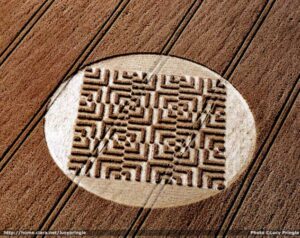In the summer of 2004, deep in the lush borderland between Wiltshire and Berkshire, something extraordinary appeared in the fields near Savernake Forest, a few miles south-east of Marlborough. On the morning of July 11th, a local farmer discovered an enormous, perfectly symmetrical pattern pressed into a field of ripened wheat — a design so mathematically complex it seemed to shimmer and move when viewed from above.
The formation, later documented by the team at Crop Circle Connector (cropcircleconnector.com), was approximately 250 feet in diameter, formed from a dense diamond-grid lattice enclosed within a circular boundary. At first glance, it resembled a woven basket or a piece of ancient digital code. But look longer, and your eyes start to dance. The alternating light and dark patterns, caused by the interplay of laid and standing wheat, create a hypnotic depth illusion — a design that seems to fold in on itself like a spinning optical maze.
The effect was so striking that even seasoned crop circle photographers described it as “mind-bending.” One observer wrote that standing at the edge of the pattern felt like “watching reality ripple.”
Discovery and Documentation
The formation was first reported in mid-July, with aerial photographs captured by the Crop Circle Connector research team — one of the few dedicated organisations that track and archive the phenomenon across southern England each summer. The formation’s location was notable: Savernake Forest, an ancient royal hunting ground dating back to before the Norman Conquest, a place steeped in myth, ley lines, and tales of strange lights among the oaks.
The site sits along a major energetic corridor known as the Avebury–Silbury ley system, which links several of Britain’s most powerful megalithic locations. Many long-time researchers, including Lucy Pringle (lucypringle.co.uk) and Colin Andrews (colinandrews.net), have documented how crop formations often cluster along these geomagnetic lines — areas where subtle variations in earth energy seem to coincide with recurring circle activity.
Witnesses noted that the wheat was neatly bent at the base, not broken, and that the pattern’s alignment with tractor lines was flawless, implying advanced geometric planning or precision beyond a casual overnight hoax.
A Study in Illusion and Intelligence
What makes the Savernake design so fascinating is its ability to trick the human brain. The lattice grid creates what psychologists call ambiguous depth perception: depending on how light hits the pattern, it can appear convex or concave, shifting between a raised diamond and a sunken void. Even in photographs, the illusion persists — some viewers report mild dizziness or visual “rippling” when staring at it too long.
To mathematicians and graphic designers, this formation stands out as a masterclass in optical geometry — a real-world application of Moiré interference patterns, where repetitive grids generate false depth and motion. To others, it’s something more.
Researchers attuned to symbolic meaning see in it the woven fabric of consciousness itself — a visual metaphor for the gridwork of reality. The interlocking diamonds could represent the “matrix” described in ancient mystical systems, where matter and spirit interlace like threads in a cosmic tapestry. The circular boundary enclosing the grid evokes wholeness — the finite world containing the infinite.
As one commentator on Crop Circle Connector wrote:
“It’s as if someone — or something — wanted to show us the structure of the universe, and did it in a field of wheat.”
Science and Skepticism
Naturally, not everyone was convinced of supernatural origins. The UK has long hosted skilled circle-makers, and the early 2000s were a golden era for elaborate “team builds.” Groups like the Circlemakers Collective have publicly demonstrated how even large, complex designs can be achieved overnight using ropes, boards, and GPS coordinates.
However, many observers — including some with engineering backgrounds — noted that Savernake’s perfect consistency of line width and the optical illusion effect would have required millimetre precision across hundreds of feet. Achieving that in darkness, on sloping ground, without aerial reference, strains credulity.
Adding to the intrigue, several witnesses reported magnetic disturbances and “metallic ticking” noises near the site in the days after its appearance. Similar anomalies have been recorded at other Wiltshire formations, leading some researchers to hypothesise microwave or electromagnetic involvement — echoing the laboratory work of Dr. W.C. Levengood at BLT Research (bltresearch.com), who found evidence of rapid heating and node elongation in crops exposed to unknown energy sources.
Symbolism: The Fabric of Reality
From a mythic perspective, the Savernake pattern reads like a message in structure. The square grid represents order and rational thought — the architecture of mind. The circle, enclosing it, represents spirit or unity. The two together — logic contained by consciousness — could be interpreted as a bridge between human intelligence and the intelligence of nature.
Some have even linked the design to the Flower of Life — a sacred geometric symbol said to encode creation’s blueprint. The repeating diamonds could symbolise cells dividing, universes replicating, or the binary pulse of existence itself: on/off, being/non-being, light/dark.
To the mystically inclined, Savernake feels like a visual koan — a paradox to meditate on. The longer you look, the less you see a “pattern” and the more you feel its pulse.
Legacy
Two decades on, the Savernake Forest crop circle remains one of the most underappreciated works of the phenomenon’s modern era. It lacks the flashy spirals of Milk Hill or the headline-grabbing scale of Alton Barnes, but those who study it closely often call it one of the most intellectually disorienting formations ever recorded.
Even today, digital artists and optical designers reference Savernake’s pattern as an example of nature and geometry merging into pure perception. Whether human-made or otherworldly, it stands as a reminder that true mystery doesn’t always shout — sometimes, it hums quietly in the wheat.
In the words of one Wiltshire researcher:
“You don’t look at the Savernake circle — you look through it. And something looks back.”
